A newly discovered space rock will pass safely near Earth later today (October 15) at only about a quarter of the Moon’s average distance.
THE asteroidcalled 2025 TP5, will cruise near our planet at 4:09 p.m. EDT (2009 UTC) at a minimum distance of 60,328 miles (97,089 km), according to data from NASA Jet Propulsion Laboratory. (NASA is shut down, like much of the U.S. government, but critical activities like the search for potentially dangerous asteroids can continue.) By comparison, average distance to the moon is 238,855 miles (384,400 kilometers).
After passing through Earth2025 TP5 will perform a close flyby of the moon the next day Thursday (Oct. 16), flying as close to the lunar surface as 74,616 miles (120,084 km), JPL said. It is a medium-sized asteroid: with an estimated diameter of around 16 meters, according to JPL, 2025 TP5 is roughly the same scale as the six-story asteroid. Chelyabinsk Meteor which broke over Russia in 2013.
Although 2025 TP5 came relatively close to Earth in September 1979, astronomers did not discover the space rock until Tuesday (October 13) around 4:07 a.m. EDT (08:07 UTC) using the Asteroid Land Impact Last Warning System (ATLAS), at a facility on Mauna Kea, Hawaii. Astronomers were the first to publish their observations on a circular around 2025 TP5 shared by the Minor Planet Center, which is a branch of the International Astronomical Union that brings new discoveries to the community.
ATLAS is a four-telescope early warning system for asteroids developed by the University of Hawaii and funded by NASAaccording to the ATLAS website. Although its design was to search for potentially dangerous asteroids, this one did not pose a threat.
Astronomers have spent several decades cataloging threatening-sized asteroids that could cross Earth, and have found no imminent threats to our planets after decades of searching. Indeed, technology has improved so much that it is common to find several small asteroids approaching Earth each month, including one earlier last October that passed overhead at the altitude of International Space Station.









